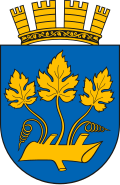Stavanger
Stavanger | |
|---|---|
 Top:View of Valberg Tower and Kartblad waterfront area, Middle left:Pulpit Rock in Ryfylke area, Center:Monument in Battle of Hafrsfjord, Middle right:Gamle area, Bottom:View of Vagen and Stavanger area | |
| Nickname: The Oil Capital | |
| Country | Norway |
| Municipality | Stavanger |
| County | Rogaland |
| District | Jæren |
| Established | 1125 |
| Government | |
| • Mayor | Christine Sagen Helgø |
| Area | |
| • City | 71 km2 (27 sq mi) |
| • Urban | 77.98 km2 (30.11 sq mi) |
| • Metro | 2,598 km2 (1,003 sq mi) |
| Population (2011) | |
| • City | 126,469 |
| • Density | 1,800/km2 (4,600/sq mi) |
| • Urban | 197,852 |
| • Urban density | 2,500/km2 (6,600/sq mi) |
| • Metro | 297,569 |
| • Metro density | 110/km2 (300/sq mi) |
| • Municipality/ Urban rank | 4th/3rd |
| • Metro rank | 3rd |
| Demonym | Siddis |
| Ethnic groups | |
| • Norwegians | 88.7% |
| • Poles | 6.7% |
| • British | 4.6% |
| Time zone | UTC+1 (CET) |
| • Summer (DST) | UTC+2 (CEST) |
| Website | stavanger.kommune.no |
Stavanger Municipality
Stavanger kommune | |
|---|---|
|
| |
 Stavanger within Rogaland | |
| Country | Norway |
| County | Rogaland |
| Time zone | UTC+01:00 (CET) |
| • Summer (DST) | UTC+02:00 (CEST) |
| ISO 3166 code | NO-1103[1] |
| Year | Pop. | ±% |
|---|---|---|
| 1769 | 3,337 | — |
| 1951 | 50,617 | +1416.8% |
| 1960 | 52,835 | +4.4% |
| 1970 | 81,741 | +54.7% |
| 1980 | 89,913 | +10.0% |
| 1990 | 97,570 | +8.5% |
| 2000 | 108,818 | +11.5% |
| 2010 | 123,850 | +13.8% |
| Source: Statistics Norway[3][4] | ||
Stavanger (/stəˈvaŋə/; Norwegian pronunciation: [stɑˈʋɑŋər] ⓘ) is a city and municipality in Norway. The city is the third largest urban zone[2] and metropolitan area[3] in Norway (through conurbation with neighbouring Sandnes) and the administrative centre of Rogaland county. The municipality is the fourth most populous in Norway. Located on the Stavanger Peninsula in Southwest Norway, Stavanger counts its official founding year as 1125, the year Stavanger cathedral was completed. Stavanger's core is to a large degree 18th and 19th century wooden houses[4] that are protected and considered part of the city's cultural heritage. This has caused the town centre and inner city to retain a small-town character with an unusually high ratio of detached houses,[5] and has contributed significantly to spreading the city's population growth to outlying parts of Greater Stavanger.
The city's rapid population growth in the late 1900s was primarily a result of Norway's booming offshore oil industry. Today the oil industry is a key industry in the Stavanger region and the city is widely referred to as the Oil Capital of Norway.[6] The largest company in the Nordic region,[7] Norwegian energy company Statoil is headquartered in Stavanger. Multiple educational institutions for higher education are located in Stavanger. The largest of these is the University of Stavanger, which offers doctorates in Petroleum Technology and Offshore Technology among others.
Domestic and international military installations are located in Stavanger, among these is NATO's Joint Warfare Center. Other international establishments, and especially local branches of foreign oil and gas companies, contribute further to a significant foreign population in the city. Immigrants make up 11.3% of Stavanger's population.[8] Stavanger has since the early 2000s consistently had an unemployment rate significantly lower than the Norwegian and European average. In 2011, the unemployment rate was less than 2%.[9] The city is also among those that frequent various lists of expensive cities in the world, and Stavanger has even been ranked as the world's most expensive city by certain indexes.[10][11][12]
Stavanger is served by international airport Stavanger Airport, Sola, which offers flights to cities in most major European country, as well as a limited number of intercontinental charter flights. The airport was named most punctual European regional airport by flightstats.com in 2010.[13]
History
The first traces of settlement in the Stavanger region come from the days when the ice retreated after the last ice age ca. 10,000 years ago. A number of historians have argued convincingly that North-Jæren was an economic and military centre as far back as the 9th-10th century with the consolidation of the nation at the Battle of Hafrsfjord around 872. Stavanger grew into a centre of church administration and an important south-west coast market town around 1100–1300.[14]
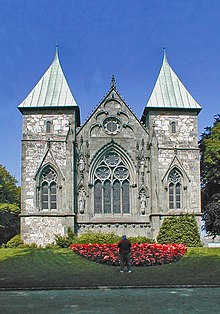
Stavanger fulfilled an urban role prior to its status as city (1125), from around the time the Stavanger bishopric was established in the 1120s. Bishop Reinald, who may have come from Winchester, England, is said to have started construction of Stavanger Cathedral (Stavanger domkirke) around 1100.[15] It was finished around 1125, and the city of Stavanger counts 1125 as its year of foundation.[16]
With the Protestant Reformation in 1536, Stavanger's role as a religious centre declined, and the establishment of Kristiansand in the early 17th century led to the relocation of the bishopric. However, rich herring fisheries in the 19th century gave the city new life. Stavanger was established as a municipality 1 January 1838 (see formannskapsdistrikt). The then rural municipalities of Hetland and Madla merged with Stavanger 1 January 1965.
The city's history is a continuous alternation between economic booms and recessions. [17] For long periods of time its most important industries have been shipping, shipbuilding, the fish canning industry and associated subcontractors.
In 1969, a new boom started as oil was first discovered in the North Sea. [18] After much discussion, Stavanger was chosen to be the on-shore center for the oil industry on the Norwegian sector of the North Sea, and a period of hectic growth followed.[18]
Coat of arms
Hallvard Trætteberg (1898–1987), a leading specialist in heraldry, was commissioned to design the official coat of arms of Stavanger, a work that lasted from the end of the 1920s and until approved in 1939. His design is also used as the city's arms, flag and seal. The coat of arms is based upon a seal which dated 1591. It shows a branch of vine (Vitis vinifera). Which leaves and branch type that is depicted on the coat of arms has been hotly debated. The original meaning and representation of the vine remains unknown.[19]
Origin of the name
The Old Norse form of the name was Stafangr. The origin of the name has been discussed for decades, and the most used interpretation is that it originally was the name of the inlet now called Vågen which was the original of the city on the east shore of the bay. [citation needed]
The first element of the name is stafr meaning 'staff, branch'. This could refer to the form of the inlet, but also to the form of the mountain Valberget Staven meaning the staff is a common name of high and steep mountains in Norway. The last element is angr meaning 'inlet, bay'. Facing the North Sea, Stavanger has always been economically dependent on its access to the sea.[20]
Boroughs

Stavanger is officially partitioned into 22 parts and 218 subparts. Stavanger is also divided into 7 boroughs.[21]
Economy
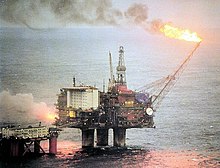
Starting in the 1880s, industry grew in Stavanger, primarily based on treatment and exports of fish and fish-products. The industry was however one-sided which left it vulnerable to changes in demand and was therefore particularly hard hit by the economic depressions between World War I and World War II. [citation needed]

After World War II, the canning-industry hit difficulties. Increased competition from abroad and old machinery led to decrease which was only partially compensated by an increase in shipping and boat-building. [citation needed]
In the 1960s, exploratory oil-drilling in the North Sea changed the situation for Stavanger. It is located close to the oil-fields, and Stavanger with its good harbour and plane-connections was well-positioned to take advantage of the increased activity.
After petroleum-exploration and production became the most important business sector in the Stavanger area during the mid-1970s, business and cultural climate has changed considerably.
The largest oil company in Stavanger is mainly state-owned oil company Statoil who have their headquarters located in the suburban area of Forus, located between neighboring Sandnes and Stavanger.
The NATO Joint Warfare Centre is located at Jåttå.
The presence of oil companies offering high paying jobs have greatly increased the average income of the population. The influx of well-paid residents has also contributed to increasing the housing costs to among the highest in Norway, in some segments even surpassing Oslo. In 2011, the average price apartments at around 80 square metres was 41400 NOK per square metre.[22]
Transport
This article needs to be updated. (November 2010) |
Access to Stavanger is provided through the Sørlandsbanen railway, and the road E39 from Kristiansand and E39 north on the west coast. Stavanger Airport, Sola has connections to domestic and European destinations, including Frankfurt, Amsterdam, London, Aberdeen, Manchester and Copenhagen. Also, located outside Stavanger, there is a port serving ferries to Hirtshals, Denmark. There have been advocates for the Smyril Line ferry between the Faroe Islands and Denmark to make a stop in Stavanger as the new port in Risavika allows this to be done while only adding one hour to the total sailing time. Local ferries go to Tau and Kvitsøy, while fast passenger boats go to many villages and islands between the main routes from Stavanger to Haugesund and Sauda. Flaggruten operates catamaran passenger services to Bergen with multiple stops along the way, among others Haugesund. Express bus services are operated by NOR-WAY Bussekspress from Stavanger City Terminal to Kristiansand, Bergen and Haugesund, and by Lavprisekspressen to Oslo via Kristiansand. There are plans to reestablish the ferry link to Newcastle in the United Kingdom, which was suspended in 2008.[23]
Public transport
The local bus service in Stavanger is administered by Rogaland Kollektivtrafikk (RKT) under the brand name "Kolumbus".[24] The buses are operated by Boreal Transport. RKT administers all bus routes in Rogaland County.
On 12 January 2009, Kolumbus initiated an express bus service to the large commercial district Forus located south of the city. This service consists of seven direct express routes that run mornings and afternoons.[25] The express buses run from different neighbourhoods in Stavanger directly to Forus, without passing through the city centre, like all other regular routes.
The recently upgraded Jæren Commuter Rail, which runs on the Sørlandet Line between Stavanger and Sandnes, operates up to four trains per hour.[26]
The city has a number of bus services and taxis. There are two tunnel projects planned: Ryfast and Rogfast.

Education
Stavanger has several schools for the expatriate community including the British International School of Stavanger[27] and the International School of Stavanger.[28]
Stavanger has one university, the University of Stavanger with about 8,000 students. The university was formerly a university college. It was granted status as University on 1 January 2005. [29]
The population of Stavanger has a high percentage of university educated persons, with 31.3% of those above the age of 16 having higher education, compared to the national average of 24.2% (2006 figures) .[30]
Culture
European Capital of Culture 2008
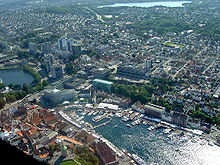
Stavanger and its region, along with Liverpool, United Kingdom, was selected as a European Capital of Culture for 2008. The Stavanger2008 vision is expressed through the concept "Open Port". This can be understood both in its English sense - "an open harbour", - and in its Norwegian meaning of "an open gate". Open Port – Openness towards the world. The region and its people is supposed to be even more open and inclusive towards art, ideas and opportunities.
Every May, Stavanger is host to MaiJazz, the Stavanger International Jazz Festival. The International Chamber Music Festival takes place every August. Stavanger was the host port of the Cutty Sark Tall Ships' Race in 1997 and 2004.
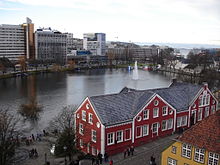
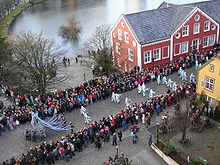
Sport and recreation
The largest local football club Viking FK, plays in the Norwegian Premier League (2010). The club plays its home matches at the football stadium, Viking Stadion, which was opened in 2004.
FK Vidar, currently play football in the Norwegian third division.
Stavanger Oilers plays in the Norwegian ice hockey elite league, GET-ligaen. The handball team Stavanger Håndball plays in the Norwegian second division.
Stavanger is the host of the 2010 beach volleyball SWATCH FIVB World Championships.
Music
Stavanger is the home of the Stavanger Symphony Orchestra (SSO). Covering another part of the musical spectrum, it is also home to gothic metal bands Theatre of Tragedy, Tristania, Sirenia and the singer Liv Kristine and the black metal band Gehenna (band), among others. Janove Ottesen and Geir Zahl founding members of the alternative rockband Kaizers Orchestra both live in Stavanger as well. The band Kvelertak has its roots as well in Stavanger.
Film
Stavanger has also been the shooting location for Norwegian movies such as Mongoland, NOKAS and Mannen som elsket Yngve (The Man Who Loved Yngve), which received some recognition by Variety magazine.[31]
Tourism
Outdoor activities
Lysefjorden is popular for hiking. Tourists typically visit places like Prekestolen (aka the Pulpit Rock), and Kjeragbolten. Prekestolen is a massive rock overhanging the fjord (604 meters below). Kjeragbolten is a rock wedged in the cliff approx. 1000 meters above the fjord. The straight fall 1000 meters down to the fjord makes Kjerag a very popular location for BASE jumping.
Not too far from Stavanger, alpine centers are ready for skiers and snowboarders throughout the winter season. [32]
Along the coast south of Stavanger there are a number of large, sandy beaches, including at Sola is within closest reach from the city.[33]
City centre

Old Stavanger (Gamle Stavanger) is located right next to the city centre and has a collection of 18th and 19th century wooden structures.
Stavanger domkirke (St. Svithun's cathedral) was built between 1100 and 1150 by the English bishop Reinald in Anglo-Norman style, and in the late 13th century a new choir was added in Gothic style, with a vaulted roof. The cathedral is the only Norwegian cathedral that is almost unchanged since the 14th century.
The city centre itself is small and intimate, with narrow streets and open spaces protected from car traffic. The open-air vegetable market is one of the very few in Norway where you can buy produce directly from local farmers every working day through the year. Unfortunately the Market has been in decline of recent years, it is now filled with very few stall holders. [citation needed]
Museums
Stavanger Museum is also located in Old Stavanger, commemorating the city's past glory as the herring capital of Norway.[34]
The Museum of Archaeology is one of five archaeological museums in Norway. According to the museum itself, it follows a profile of environmental archaeology and interdisciplinary study, with a scientific staff that includes representatives from archaeology, the natural sciences and modern cultural history.
The Norwegian Petroleum Museum is located at the harbour. The museum reflects the fact that Stavanger has been Norway's oil capital since oil drilling activities started in the North Sea in 1966.[35]
Climate
The city is located on a peninsula on the southwest coast of Norway. The climate is maritime mild temperate (marine west coast - cfb) and rather windy, with all monthly temperature averages above freezing, and precipitation 1180 mm/year. Summers are pleasant and lowland areas in and around Stavanger have the longest growing season in Norway.
| Climate data for Stavanger(1961-90) | |||||||||||||
|---|---|---|---|---|---|---|---|---|---|---|---|---|---|
| Month | Jan | Feb | Mar | Apr | May | Jun | Jul | Aug | Sep | Oct | Nov | Dec | Year |
| Mean daily maximum °C (°F) | 3 (37) |
3 (37) |
5 (41) |
9 (48) |
14 (57) |
16 (61) |
18 (64) |
18 (64) |
15 (59) |
11 (52) |
7 (45) |
5 (41) |
10.3 (50.5) |
| Mean daily minimum °C (°F) | −1 (30) |
−1 (30) |
0 (32) |
3 (37) |
7 (45) |
9 (48) |
12 (54) |
12 (54) |
10 (50) |
7 (45) |
4 (39) |
2 (36) |
5.3 (41.5) |
| Average precipitation mm (inches) | 92 (3.6) |
66 (2.6) |
75 (3.0) |
50 (2.0) |
68 (2.7) |
73 (2.9) |
91 (3.6) |
115 (4.5) |
156 (6.1) |
148 (5.8) |
136 (5.4) |
110 (4.3) |
1,180 (46.5) |
| Mean monthly sunshine hours | 48 | 79 | 140 | 168 | 226 | 222 | 197 | 159 | 141 | 80 | 45 | 33 | 1,538 |
| Source: climatedata[36] | |||||||||||||
Notable people
Twin towns - sister cities
Stavanger has several sister cities; they are:
 Aberdeen, Scotland[37]
Aberdeen, Scotland[37] Macaé, Brazil [38]
Macaé, Brazil [38] Baku, Azerbaijan
Baku, Azerbaijan Antsirabe, Madagascar
Antsirabe, Madagascar Esbjerg, Denmark
Esbjerg, Denmark Eskilstuna, Sweden
Eskilstuna, Sweden Estelí, Nicaragua
Estelí, Nicaragua Neskaupstaður, Iceland
Neskaupstaður, Iceland Galveston, United States
Galveston, United States Harlow, England
Harlow, England Toulouse, France
Toulouse, France Houston, United States
Houston, United States Jyväskylä, Finland
Jyväskylä, Finland Nablus, Palestinian Authority
Nablus, Palestinian Authority Netanya, Israel
Netanya, Israel Massawa, Eritrea
Massawa, Eritrea Chesterfield, England
Chesterfield, England
References
- ^ Bolstad, Erik; Thorsnæs, Geir, eds. (26 January 2023). "Kommunenummer". Store norske leksikon (in Norwegian). Kunnskapsforlaget.
- ^ "Statistics Norway: Conurbations ranked after area and population". Statistics Norway (in Norwegian). Ssb.no. 09-01-01. Retrieved 2009-09-21.
{{cite web}}: Check date values in:|date=(help) - ^ "The Stavanger region". 05-03-10. Retrieved 2013-01-05.
{{cite web}}: Check date values in:|date=(help) - ^ "Gamle Stavanger" (in Norwegian). 5 January 2013. Retrieved 5 January 2013.
- ^ "Boforhold, flytting og befolkningsutvikling i storbyene" (PDF) (in Norwegian). sintef.no. 1 January 2000. Retrieved 5 June 2012.
- ^ Stavanger - The Norwegian Petroleum Capital
- ^ "The Global 2000". Forbes. 21 April 2010.
- ^ Facts on Stavanger's immigrant population "Fakta om innvandrer- befolkningen i Stavanger" (PDF) (in Norwegian). imdi.no. 2007. Retrieved 6 June 2012.
- ^ "Stavangerstatistikken - arbeidsløshet" (in Norwegian). stavanger.kommune.no. 6 June 2012. Retrieved 6 June 2012.
- ^ "The World's Most Expensive Cities 2010". businessweek.com. 2011. Retrieved 6 June 2012.
- ^ "Numbeo Costs of Living". numbeo.com. 6 June 2012. Retrieved 6 June 2012.
- ^ Results from ECA International survey "And the world's most expensive city for expats is ... Tokyo". numbeo.com. 7 December 2011. Retrieved 6 June 2012.
- ^ "2010 Airports - Best On-time Performance Awards". flightstats.com. 2011. Retrieved 6 June 2012.
- ^ Phenomenology and the pioneer settlement on the Western Scandinavian Peninsula (Ingrid Fuglestvedt (2009) Lindome : Bricoleur Press) ISBN 978-91-85411-07-8
- ^ Ancient See of Stavanger (Catholic Encyclopedia)
- ^ http://www.uarctic.org/SingleNewsArticle.aspx?m=668&amid=6229
- ^ Stavanger kommune - Byhistorie
- ^ a b Stavanger kommune - Byhistorie
- ^ The Coat of Arms of Norway (The American-Scandinavian Review, June 1964)
- ^ stafr (Wiktionary)
- ^ List of boroughs in Oslo, Bergen, Trondheim and Stavanger
- ^ Solberg, Stig Martin (24 August 2011). "Her er det dyrest å være fattig" (in Norwegian). NA24. Retrieved 1 April 2012.
- ^ http://www.journallive.co.uk/north-east-news/todays-news/2012/08/27/north-shields-to-norway-ferry-plan-raises-job-hopes-61634-31703489/
- ^ [1]
- ^ [2]
- ^ http://www.aftenbladet.no/lokalt/1102953/Dobbeltsporet_endelig_godkjent.html
- ^ British International School of Stavanger
- ^ Norway, Stavanger: International School of Stavanger
- ^ University of Stavanger - Norway - About us
- ^ SSB: Figures on Stavanger Municipality
- ^ Simon, Alissa (25 November 2008). "The Man Who Loved Yngve Movie Review". Variety.
- ^ Statistics - Stavanger BASE Klubb
- ^ Beaches of Rogaland in west Norway - Stavanger Travel
- ^ Stavanger Museum
- ^ Norsk Oljemuseum
- ^ "Climate Stavanger". Climatedata.
{{cite web}}:|access-date=requires|url=(help); Missing or empty|url=(help); Unknown parameter|url http://www.climatedata.eu/climate.php?loc=ignored (help) - ^ "Twinning". Aberdeen City Council. Retrieved 2 March 2008.
- ^ "Prefeito recebe comitiva da Noruega interessada em investir em Macaé". Retrieved 2012-14-09.
{{cite web}}: Check date values in:|accessdate=(help)
External links
- Municipality web site
- Official City Maps
- Stavanger Web
- Official web site of the region Stavanger
- Stavanger Expats
 Stavanger travel guide from Wikivoyage
Stavanger travel guide from Wikivoyage

